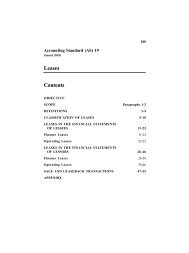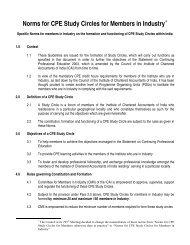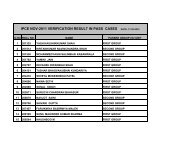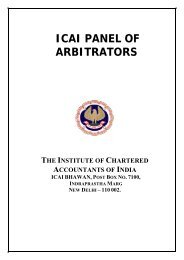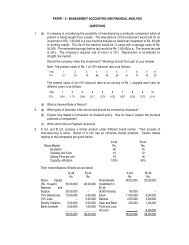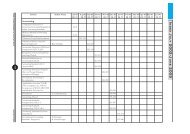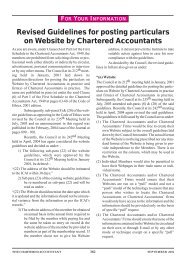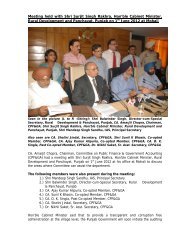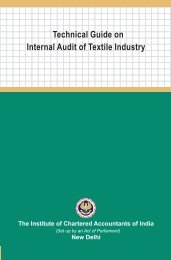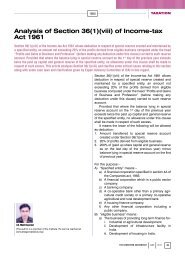The Chartered Accountant
The Chartered Accountant
The Chartered Accountant
Create successful ePaper yourself
Turn your PDF publications into a flip-book with our unique Google optimized e-Paper software.
counts the nominal amount of<br />
the instrument to the current<br />
cash sales price of the goods<br />
or services.<br />
<strong>The</strong> difference between the fair value<br />
and the nominal amount of the consideration<br />
is recognised as interest revenue<br />
in accordance with paragraphs<br />
31 and 32.<br />
15. When goods or services are exchanged<br />
or swapped for goods or services<br />
which are of a similar nature and<br />
value, the exchange is not regarded as<br />
a transaction which generates revenue.<br />
This is often the case with commodities<br />
where suppliers exchange or swap<br />
inventories in various locations to fulfill<br />
demand on a timely basis in a particular<br />
location. When goods are sold<br />
or services are rendered in exchange<br />
for dissimilar goods or services, the<br />
exchange is regarded as a transaction<br />
which generates revenue. <strong>The</strong> revenue<br />
is measured at the fair value of the<br />
goods or services received, adjusted<br />
by the amount of any cash or cash<br />
equivalents transferred. When the<br />
fair value of the goods or services<br />
received cannot be measured reliably,<br />
the revenue is measured at the fair value<br />
of the goods or services given up,<br />
adjusted by the amount of any cash or<br />
cash equivalents transferred.<br />
Identification of the Transaction<br />
16. <strong>The</strong> recognition criteria in this<br />
Standard are usually applied separately<br />
to each transaction. However, in certain<br />
circumstances, it is necessary to<br />
apply the recognition criteria to the<br />
separately identifiable components of<br />
a single transaction in order to reflect<br />
the substance of the transaction. For<br />
example, when the price of a product<br />
includes an identifiable amount for<br />
subsequent servicing, that amount is<br />
deferred and recognised as revenue<br />
over the period during which the service<br />
is performed. Conversely, the recognition<br />
criteria are applied to two or<br />
more transactions together when they<br />
are linked in such a way that the effect<br />
cannot be understood without reference<br />
to the series of transactions as<br />
a whole. For example, an entity may<br />
sell goods and, at the same time, enter<br />
DECEMBER 2008 1074 THE CHARTERED ACCOUNTANT<br />
STANDARDS<br />
into a separate agreement to repurchase<br />
the goods at a later date, thus<br />
negating the substantive effect of the<br />
transaction; in such a case, the two<br />
transactions are dealt with together.<br />
Rendering of Services<br />
17. When the outcome of a transaction<br />
involving the rendering of<br />
services can be estimated reliably,<br />
revenue associated with the transaction<br />
should be recognised by reference<br />
to the stage of completion<br />
of the transaction at the reporting<br />
date. <strong>The</strong> outcome of a transaction<br />
can be estimated reliably when all<br />
the following conditions are satisfied:<br />
(a) <strong>The</strong> amount of revenue can<br />
be measured reliably;<br />
(b) It is probable that the economic<br />
benefits or service<br />
potential associated with<br />
the transaction will flow to<br />
the entity;<br />
(c) <strong>The</strong> stage of completion<br />
of the transaction at the<br />
reporting date can be measured<br />
reliably; and<br />
(d) <strong>The</strong> costs incurred for the<br />
transaction and the costs<br />
to complete the transaction<br />
can be measured reliably.<br />
18. <strong>The</strong> recognition of revenue by reference<br />
to the stage of completion of a<br />
transaction is often referred to as the<br />
percentage of completion method.<br />
Under this method, revenue is recognised<br />
in the reporting periods in<br />
which the services are rendered. For<br />
example, an entity providing property<br />
valuation consultancy services would<br />
recognise revenue as the individual<br />
valuations are completed. <strong>The</strong> recognition<br />
of revenue on this basis provides<br />
useful information on the extent<br />
of service activity and performance<br />
during a period.<br />
19. Revenue is recognised only when it<br />
is probable that the economic benefits<br />
or service potential associated with<br />
the transaction will flow to the entity.<br />
However, when an uncertainty arises<br />
about the collectability of an amount<br />
already included in revenue, the un-<br />
collectable amount, or the amount in<br />
respect of which recovery has ceased<br />
to be probable, is recognised as an expense,<br />
rather than as an adjustment of<br />
the amount of revenue originally recognised.<br />
20. An entity is generally able to make<br />
reliable estimates after it has agreed to<br />
the following with the other parties to<br />
the transaction:<br />
(a) Each party’s enforceable rights<br />
regarding the service to be<br />
provided and received by the<br />
parties;<br />
(b) <strong>The</strong> consideration to be exchanged;<br />
and<br />
(c) <strong>The</strong> manner and terms of settlement.<br />
It is also usually necessary for the entity<br />
to have an effective internal financial<br />
budgeting and reporting system.<br />
<strong>The</strong> entity reviews and, when necessary,<br />
revises the estimates of revenue<br />
as the service is performed. <strong>The</strong> need<br />
for such revisions does not necessarily<br />
indicate that the outcome of the<br />
transaction cannot be estimated reliably.<br />
21. <strong>The</strong> stage of completion of a<br />
transaction may be determined by a<br />
variety of methods. An entity uses<br />
the method that measures reliably<br />
the services performed. Depending<br />
on the nature of the transaction, the<br />
methods may include:<br />
(a) Surveys of work performed;<br />
(b) Services performed to date as<br />
a percentage of total services<br />
to be performed; or<br />
(c) <strong>The</strong> proportion that costs incurred<br />
to date bear to the estimated<br />
total costs of the transaction.<br />
Only costs that reflect<br />
services performed to date are<br />
included in costs incurred to<br />
date. Only costs that reflect<br />
services performed or to be<br />
performed are included in the<br />
estimated total costs of the<br />
transaction.<br />
Progress payments and advances received<br />
from customers often do not<br />
reflect the services performed.



